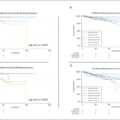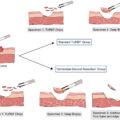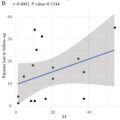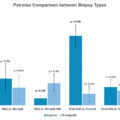Highlights
- •
Overall Survival (OS): Five studies with 272 POPRC and 324 SRC patients showed no significant difference in OS between procedures (HR 1.02; P = 0.87). No difference was noted between propensity score-matched and unmatched studies.
- •
Cancer-Specific Survival (CSS): Four studies with 209 POPRC and 275 SRC patients indicated no significant difference in CSS (HR 1.27; P = 0.22). Similarly, propensity score-matched and unmatched studies showed no difference.
- •
Recurrence-Free Survival (RFS): Four studies showed no overall difference in RFS (HR 0.85; P = 0.65). However, a significant reduction in RFS was seen in the POPRC group for propensity score-unmatched studies.
- •
Operative Time: POPRC had significantly shorter operative times (-41.73 minutes; P = 0.007), especially in propensity score-matched studies (-56.61 minutes; P < 0.0001).
- •
Complication Rate & Blood Loss: No significant differences in complication rates or estimated blood loss between POPRC and SRC, except in propensity score-matched studies where POPRC had reduced blood loss ( P = 0.005).
Abstract
Background and Objective
Radical Cystectomy is indicated in muscle-invasive bladder cancer and select cases of nonmuscle invasive bladder cancer. Women often undergo additional reproductive organ removal, greatly impacting sexual function and quality of life. Pelvic organ-preserving radical cystectomy aims to mitigate these effects, but its oncologic outcomes are not well-defined. This presents a meta-analysis of available literature on oncological outcomes of pelvic organ-preserving radical cystectomy in women with muscle invasive disease.
Methods
A systematic search across PubMed, Web of Science, Scopus, and Google Scholar was performed to identify studies comparing oncological outcomes between pelvic organ-preserving radical cystectomy and standard radical cystectomy in women with muscle-invasive bladder cancer or high-risk or recurrent nonmuscle invasive cancer. The search included English or Spanish studies, statistically comparing overall survival, cancer-specific survival, and recurrence-free survival. Statistical analysis used Review Manager, employing fixed or random-effects models based on heterogeneity.
Key Findings and Limitations
Six retrospective studies met inclusion criteria, totaling 597 patients of which 303 received pelvic organ-preserving radical cystectomy and 294 received standard radical cystectomy. Overall Survival was not different between the 2 groups (HR 1.05 [0.77, 1.43]; P = 0.77). Cancer-Specific Survival also was found to be not different between the 2 groups (HR 1.27 [0.86, 1.87]; P = 0.22). Additionally, recurrence-free survival was not different between the 2 groups (HR 0.85 [0.41, 1.75]; P = 0.65. Four of the included studies exhibited a moderate risk of bias, with 1 study demonstrating low risk and the remaining study manifesting a serious risk of bias.
Conclusion
The comparison showed no significant differences in overall survival, cancer-specific survival, or recurrence-free survival rates.
1
Introduction
In the United States, an estimated 82,290 new bladder cancer diagnoses were expected in 2023, with around 19,870 cases affecting women [ ]. Among women, bladder cancer occurs at a rate 3 to 4 times lower than in men [ ], primarily influenced by factors such as smoking and chemical exposures [ , ]. At the time of diagnosis, bladder cancer can generally be classified into 2 broad categories: muscle-invasive bladder cancer (MIBC) and nonmuscle invasive bladder cancer (NMIBC). MIBC is found in approximately 25% to 30% of newly diagnosed cases [ ]. Concerningly, studies have identified that women with MIBC are not only diagnosed at later stages than men [ , ], but also have poorer prognosis following treatment [ ].
The established standard for treatment of MIBC includes neoadjuvant chemotherapy (NAC) in eligible patients prior to standard radical cystectomy (SRC) with bilateral pelvic lymph-node dissection (PLND) [ ]. Patients with high-risk features that have failed bladder-sparing strategies are also eligible for RC. Surgery in women often includes the removal of reproductive organs including the uterus, ovaries, and anterior vaginal wall [ ]. Thus, surgical interventions in women frequently lead to distinct sexual side effects and adverse outcomes such as surgical menopause, reduced orgasm, decreased vaginal lubrication, and impaired libido, substantially impacting these patients’ quality of life [ , ].
Efforts to mitigate sexual side effects, especially in younger, sexually active bladder cancer patients, have increased interest in the development of novel approaches such as pelvic organ-preserving radical cystectomy (POPRC) [ ]. POPRC aims to preserve anatomical structures, minimizing unnecessary morbidity and maintaining sexual function in women with bladder cancer requiring radical cystectomy. The American Urological Association (AUA) guidelines recommend performing a POPRC in women when there is no tumor in the trigone or bladder base, and they recommend preserving the ovaries in the absence of direct tumor extension to preserve hormonal homeostasis [ ]. Additionally, the European Association of Urology (EAU) advocates for the implementation of sexual organ-preserving techniques in the absence of pT4 urothelial carcinoma, with the objective of minimizing positive surgical margins while also optimizing functional outcomes [ ].
Studies comparing POPRC to SRC with hysterectomy and/or anterior vaginal wall resection and oophorectomy have demonstrated that POPRC may have equivalent oncologic outcomes with improved sexual function and continence outcomes [ , ]. Several studies have previously explored this topic; however, a meta-analysis has not yet been conducted. Therefore, this study aims to aggregate and meta-analyze oncological outcomes of POPRC vs. SRC in women with MIBC and High-risk NMIBC.
2
Methods
Following the Preferred Instrument for Systematic Reviews and Meta-Analysis (PRISMA), with prior PROSPERO registration CRD42023495347, a systematic database search was performed in January 2023 with no limit on date search. Studies comparing oncological outcomes between POPRC and SRC in women with MIBC were identified by employing PubMed, Web of Science, Scopus, and Google Scholar to search for titles or abstracts that included the search terms “pelvic organ preserving radical cystectomy,” “bladder cancer,” “muscle-invasive bladder cancer,” “high-risk bladder cancer” and “radical cystectomy.” Publication date was not taken into consideration as a restriction, but linguistic inclusion was limited to English or Spanish. Only studies that directly compared POPRC vs. SRC were considered. Two separate, independent reviewers (DEHG, GS) further screened for possible inclusion, while a third reviewer (SRP) performed data conciliation. Additional articles identified through the references section of included studies were also screened.
2.1
Study inclusion
This study included both prospective and retrospective studies that statistically compared overall survival (OS), cancer-specific survival (CSS), and recurrence-free survival (RFS) as primary outcomes. Studies were also screened for non-different baseline preoperative comorbidities in studied cohorts. Secondary outcomes were operative time, length of stay, complication rate and estimated blood loss.
2.2
Statistical analysis
Data analysis was performed in Review Manager (RevMan) V 5.4.2 (Cochrane). Heterogeneity was assessed using Higgins I2% [ ]. Variables with over 50% I2 were considered heterogeneous and were analyzed through a Random-Effects model. Otherwise, a Fixed-Effects model was used. Analysis was performed using the generic Inverse-Variance method, using RevMan’s built-in calculator to estimate the logarithmic function and standard error from provided HR and confidence intervals. HR was estimated for studies providing only survival curves but not HR using Tierney’s method. Values are expressed as HR with 95% confidence intervals. Continuous data is reported in mean difference (MD) with 95% confidence intervals (CI). Dichotomous data such as complications were reported using Odds Ratios (OR) with 95% CI. The resulting values with associated P -values < 0.05 were considered significant. Furthermore, the studies were stratified into 2 cohorts: those employing propensity score matching and those without propensity score adjustment. P values of 0.05 and less were considered statistically significant. The Risk of Bias in Nonrandomized Studies of Interventions (ROBINS-I) tool was used to assess the publication bias of the included studies [ ]. A sensitivity analysis was performed in variables with > 25% heterogeneity through sequential exclusion of studies until heterogeneity reached or was as close as possible to 0% while still having at least 2 studies.
3
Results
Six retrospective studies that met the inclusion criteria were analyzed, encompassing a total of 709 patients, with 366 receiving POPRC and 343 receiving SRC [ , ]. The overall characteristics of these studies are presented in Table 1 . Only 2 studies were propensity score matched. The mean age did not differ significantly between the groups across any included studies. PRISMA flow chart is shown in Fig. 1 .
| Author, year | Study Type | Type | Inclusion | Exclusion | Surgical Technique | Total, N | Propensity matched, N | Age, mean (SD) | Follow-up, mean (SD) | Stage, N (%) | Positive Surgical Margins, N (%) | Trigone Involvement, N (%) | Chemotherapy | ≥ T3, N (%) |
|---|---|---|---|---|---|---|---|---|---|---|---|---|---|---|
| Bai, 2018 | Retrospective | POPRC | Female sex, aged ≥75 years, stage ≥T2, and underwent RC with pelvic lymph node dissection followed by bilateral cutaneous ureterostomy. | Metastatic disease, salvage cystectomy, nephrectomy prior to RC, and RC combined with other types of urinary diversion. | The bladder and part of the urethra were removed en bloc, and in cases of hydronephrosis or tight adhesions, a portion of the anterior vaginal wall was also removed. | 51 | 45 | 77.7 (2.6) | 34 (39.05), months | T2: 36 (80), T3: 5 (11.1), T4: 4 (8.9) | NR | NR | NR | SRC: 18 (21.4) POPRC: 11 (21.6) Non-significant difference |
| SRC | Excision of the bladder, adjacent vagina, and uterus. | 84 | 45 | 78.8 (4.2) | 35 (28.30), months | T2: 36 (80), T3: 6 (13.3), T4: 3 (6.7) | NR | NR | NR | |||||
| Gross, 2018 | Retrospective | POPRC | Tumor located away from the trigone, tumor did not appear to have any contact with the vagina on visualized digital palpation during cystoscopy, and if bladder neck biopsies were negative. | NR | Vagina + uterus preserved | 25 | NA | 56.15 (9.21) | 6.3 (4.7), years | T1: 5 (22.7) T2a: 9 (40.9), T2b: 2 (9), T3a: 1 (4.5), T3b: 3 (13.6) T4: 0 ypT2: 2 (9) | 0 | Patients with trigone involvement were excluded | Neoadjuvant: 2 (7.4%) Adjuvant/palliative: 5(20%) | SRC: 24 (25.5) POPRC: 4 (14.8) Non-significant difference |
| SRC | Hysterectomy either pre-op or intraop and only sometimes vaginal resection. | 85 | NA | 60.4 (7.7) | 7.2 (3.9), years | T1: 15(20.8) T2a: 16 (22.2), T2b: 10 (13.9), T3a: 6 (8.3) T3b: 16 (22.2), T4: 2 (2.8) ypT0: 2 (2.8) ypT1: 1 (1.4) ypT2: 2 (2.8) ypT4: 2 (2.8) | 0 | Neoadjuvant: 9 (9.6%) Adjuvant/palliative: 12 (14.1%) | ||||||
| Huang, 2019 | Retrospective | Uterus sparing -RC | T2-4aN0-xM0, high risk and recurrent NMIBC and BCG-resistant Tis, extensive papillary disease that cannot be controlled with TUR-Bt and intravesical therapy alone. | Male sex, lost to follow-up and patients with a previous hysterectomy | Uterus preserved | 63 | NA | 67.3 (12.2) | 40.3(39.8) | Ta, Tis, T1: 18(28.6%); T2: 36(41.3%); T3: 19(30.2%); T4: 0 | 3 (4.8) | 43 (68.3) | Neoadjuvant or Adjuvant: 7(11.3%) | SRC: 21 (42.9) Uterus sparing-RC: 19 (30.2) Significant p=.017 |
| SRC | NR | 49 | NA | 67.7 (9.2) | Ta, Tis, T1: 12(24.5); T2: 16(32.7); T3: 14(28.6); T4: 7(14.3) | 2 (4.1) | 37 (75.5) | Neoadjuvant or Adjuvant: 9 (18.8%) | ||||||
| Large, 2012 | Retrospective | Vaginal sparing-RC | Women with bladder urothelial carcinoma. | NR | Vagina + uterus preserved | 94 | NA | 69.1 | 845, days | ≥T2: 64.9% | 8 (8.5) | NR | NR | SRC: 78.9% Vaginal sparing-RC: 44.7% Significant p=0.01 |
| SRC | NR | 19 | NA | 73.4 | 627.9, days | ≥T2: 78.9% | 4 (21.1) | NR | NR | |||||
| Park, 2022 | Retrospective | Uterus sparing-RC | Females with MIBC or high-risk NMIBC who underwent radical cystectomy, with or without neoadjuvant chemotherapy and adjuvant chemotherapy. | Histology non compatible with major types of bladder cancer, severe intra-abdominal adhesions | Uterus preserved | 40 | NA | 63.75 (12.75) | 38.6 (61.9) | T0, Ta, Tis: 4 (10); T1: 15 (35) T2: 19 (47.5); T3: 3 (7.5); T4: 0(0) | 6 (15.0) | NR | Neoadjuvant: 7(17.5%) Adjuvant: 5 (12.5%) | SRC: 16 (44.5) USRC: 10 (27.8) |
| SRC | Uterus excised either pre-op or intraop. | 46 | NA | 67.75 (11.25) | 51.1 (98.9) | T0, Ta, Tis: 1(2.2); T1: 15 (32.6); T2: 18 (39.1); T3: 8 (17.4); T4: 4(8.7) | 4 (8.7) | NR | Neoadjuvant: 12(26.1%) Adjuvant: 12 (26.1%) | |||||
| Zhong, 2023 | Retrospective | POPRC | All female patients with bladder cancer who underwent RC for curative treatment (including high-risk nonmuscle invasive bladder cancer and MIBC) | Distant metastasis at diagnosis; surgical history of gynecology malignant tumors; concomitant with other malignant tumors; a lack of clinicopathologic data. | The vaginal wall dissected to preserve pelvic plexus components, and the urethra and bladder were removed. | 158 | 99 | ≤65: 40 (40.4%); >65: 41 (41.4%) | 38.6 (15.9-62.5), months | <T3:65 (65.7%); ≥T3:34 (34.3%) | 7 (7.1) | NR | NR | SRC: 45 (23.5) POPRC: 51 (32.3) Non-significant difference |
| SRC | Bladder, uterus, fallopian tubes, ovaries, and anterior vaginal wall removed en bloc. | 115 | 99 | ≤65: 59 (59.6%); >65: 58 (58.6%) | <T3:65 (65.7%); ≥T3:34 (34.3%) | 5 (5.1) | NR | NR |
Stay updated, free articles. Join our Telegram channel

Full access? Get Clinical Tree








